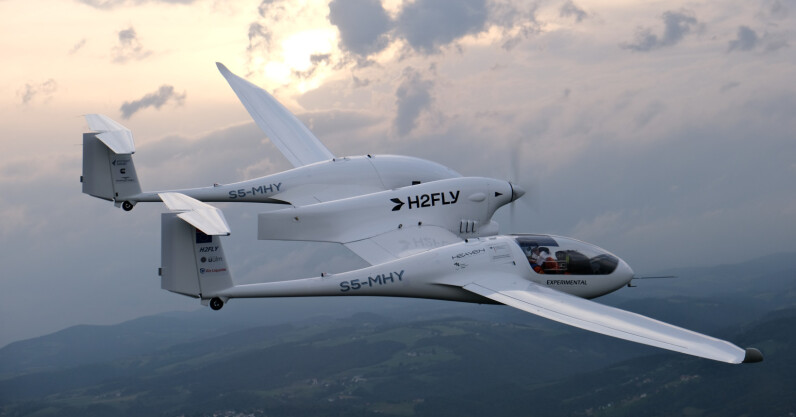At a somewhat small and unassuming airport in Maribor, Slovenia, German hydrogen propulsion startup H2FLY has quietly been building up to a major milestone in zero-emission aviation over the summer. And all the hard work has come to fruition, with the successful completion of the world’s first crewed liquid hydrogen-powered flights.
Before any aviation history enthusiast out there goes “but what about the Tupolev Tu-155?” — yes, the Soviets did try out liquid hydrogen as fuel 35 years ago, but only for one of the three engines. In contrast, H2FLY’s HY4 has now operated using only liquid hydrogen (as opposed to the gaseous kind) as fuel, relying solely on the hydrogen fuel-cell powertrain for the entire flight.
On Thursday, this TNW reporter was present for the fourth in a series of test flights. The event marked the culmination of Project HEAVEN, an EU-funded partnership undertaking to demonstrate the feasibility of using liquid, cryogenic hydrogen in aircraft. (That is short for High powEr density FC System for Aerial Passenger VEhicle fueled by liquid HydrogeN, just FYI.)
Liquid vs. gaseous hydrogen as aircraft fuel
While yesterday’s demonstration flight lasted somewhere around the 10-minute mark, a few days prior, the HY4 and its two pilots stayed in the air for 3 hours and 1 minute — a feat that required 10kg of hydrogen. If using up the aircraft’s full storage capacity of 24kg, it could stay up for 8 hours.

The <3 of EU tech
The latest rumblings from the EU tech scene, a story from our wise ol’ founder Boris, and some questionable AI art. It’s free, every week, in your inbox. Sign up now!
“It feels really amazing, it is the perfect teamwork coming to life,” said one of the pilots, Johannes Garbino-Anton, after the flight. He added that the technology “works perfectly,” and that the biggest difference to a normal aircraft is the lack of vibrations and noise. And, the lack of carbon dioxide emissions.

H2FLY’s propulsion system consists of hydrogen storage, a 120kW fuel-cell energy converter, and an electrical engine. All in all, this summer was H2FLY’s eight flight test campaign. The hydrogen-electric HY4 has been flying since 2016, but this summer’s breakthrough consists of operating the plane on liquid hydrogen, as opposed to hydrogen as gas.
Liquid hydrogen is more energy dense than its gaseous counterpart. That means that it requires significantly lower tank weights and volume. In the world of air transport, especially when retrofitting planes, this equals not having to throw out as many passenger seats, or reduce cargo space, i.e. payload.
But perhaps more significantly, it unlocks a much greater range. For the HY4 test aircraft, this equals 750km on gaseous hydrogen vs. 1,500km on liquid — or double the distance. On the other hand, liquid hydrogen requires cryogenic temperatures (around -253°C), which adds to the complexity of transporting and refuelling.
Retrofitting existing airframes with hydrogen fuel-cell propulsion system
The HY4, made out of glass fibre and carbon fibre, will not go into commercial production. The next step from H2FLY will now be to scale the fuel-cell system to megawatt capacity. The H2F-175 system will unlock not only longer range, but also altitudes of up to 27,000 feet. In a partnership with Deutsche Aircraft, the two intend to retrofit a 30-seat Dornier 328 demonstrator with H2FLY hydrogen-electric fuel cells and begin test flights by 2025.
